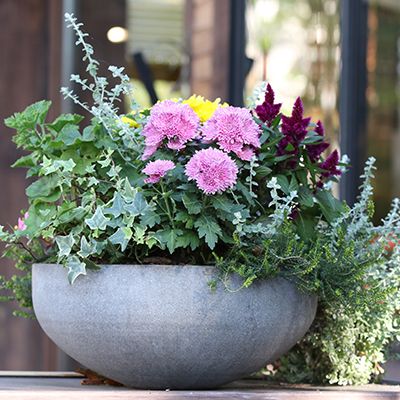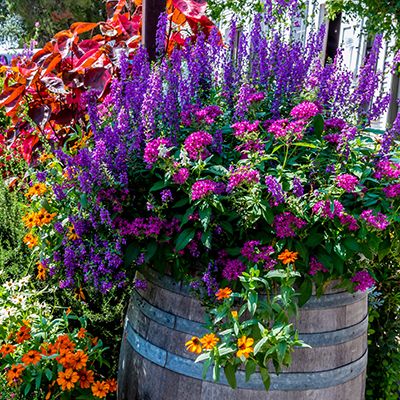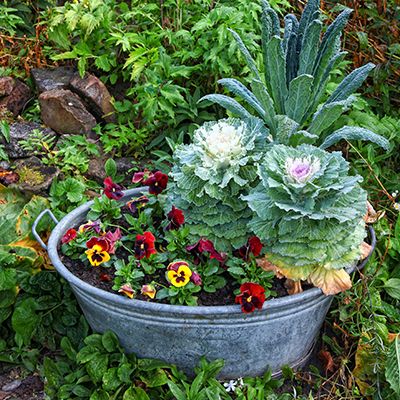


Container Gardening
The entrance of many homes is a brick or concrete walkway or possibly a porch. Often an accent plant or group of plants would be desirable at the entrance to greet visitors. A pair of (1) evergreen camellias on either side of the door will provide such a warm, friendly greeting, or an (2) everblooming gardenia is a favorite choice near a door where its delicious fragrance meets callers. On the back patio, covered with concrete, there may be a need for a plant in a corner where the building forms an "L". Perhaps a (3) Japanese maple, (4) princess flower or (5) Pieris will fill that corner. If the large patio has a barren look, several carefully placed geraniums, hibiscus, lantana or citrus will give some color and excitement to the area. Just remember, when you decorate a large area, group your plants in threes or fours and don’t lay them out along the border in a neat line, five to ten feet apart. Each of these situations (porch, patio, and corners) can only be solved by using plants growing in containers. Container gardening is for everyone. It is especially suitable for apartment or condominium residents with only a balcony or small patio for their gardening needs.
When you have decided that container grown plants will solve your needs, the first step will be to choose a container. There are many shapes but the material can be terra cotta, plastic, wood, Euracast, glazed ceramic or paper mache. Each has some positive and negative characteristics.
Briefly:
- Terra Cotta: Heavy, attractive, and moderately priced. Pot will break if you drop it.
- Porous Plastic: Lightweight, doesn’t break easily and is inexpensive. Looks like plastic although the newer varieties can be very attractive, not porous and holds water
- Wood: Attractive, same as terra cotta, but wood rots.
- Glazed Ceramic: Same as terra cotta but not porous, many colors, shapes and expensive.
- SMART POT: Something new, woven plastic fiber, light weight, porous, drains quickly, awkward to fill, may tear or snag, moderate price.
- Paper Mache: Don’t bother.
Color and texture will be your choice. Tall plants should have a heavy pot, otherwise plants grow equally well in all pots. A tray under your pot is not a requirement except that if you water plants on the third floor balcony, the tray will prevent the neighbors on the second floor from becoming upset if they get wet.
A good quality potting soil such as Gardner & Bloome® Organic Potting Soil is an absolute requirement for successful container gardening. A good quality potting soil must have a minimum of six different ingredients; Gardner & Bloome® Organic Potting Soil contains nine. Many ‘house brands’ sold by discount or hardware stores and labeled as potting soil are inferior products which should be avoided. Under no circumstances should you use garden soil or homemade compost. Neither of these will provide proper drainage or aeration and there is the danger of introducing disease or insect pests into your container.
Frequently, gardeners will ask about putting gravel or screen in the bottom of the container under the soil. The plant will better off without it because the screen can obstruct drainage and the gravel becomes another inch or two of sterile potting mix into which the roots grow and find no nutrients. A good potting mix such as Gardner & Bloome® Organic Potting Soil provides adequate drainage and excellent anchorage for the plant(s). A satisfactory cover for the drainage hole in the bottom of the container is a piece of broken terra cotta flower pot with the concave side facing down over the hole. Keep a saucer under the container with half an inch to an inch of water in it. The soil in the pot will wick up the water as needed and not drown the plants roots.
When you select plants for your containers, know if their location will be sunny, part sun, shady or deep shade. Remember rule number 12: No sun, no flowers. Select plants suitable for their environment.
Containerized plants often have to be watered more frequently than the same plants growing in garden soil. Small pots, dry out more quickly than larger pots, as do terra cotta pots when compared to plastic pots. The larger the plant, the more quickly it uses up the water in its container.
During hot weather, it would not be unusual to water containerized plants every day or every other day. Mixing hydrogel into your potting mix won’t diminish the amount of water used but it will extend the time between watering. When watering the containers, always water until it runs out the bottom of the container. If you have saucers under the containers, leave about one-half inch of water in the saucer for the pot to wick up.
Eventually, your plant(s) will outgrow their pots. The first symptoms are that the tops are not as lush as they have been and roots start creeping out of the drainage hole. You have several alternatives: throw the plant away, transplant it into the garden, pot it up into a larger container, or repot it in the same container. To repot in the same container carefully knock the plant out of the pot. The root ball should remain as a solid unit. Place the root ball on a firm surface and with a large knife or a pair of pruning shears, cut an inch or two off the entire circumference of the root ball from top to bottom. Next cut an inch or two off the bottom of the root ball. . Finally, trim the foliage on the top of the plant. Remove between one-quarter and one-third of the crown as if you were severely pruning the tops but in a neat and orderly fashion so that the plant’s symmetry is not destroyed. Replant it in the same pot which has been carefully scrubbed. Use fresh Gardner & Bloome® Organic Potting Soil. Press the soil firmly in place - do not pound down, water thoroughly and place in a semi-shady location until you see new growth and then move to its normal location. Do not fertilize the container for the next month.
Containerized plants grow in a space much smaller than normal. When growing in the garden, plants need to be fertilized about once or twice a year. The same plants growing in a container will use up all the nutrients in a good potting soil within two or three months. Consequently, evergreen plants need to be fertilized every month after the third month in the container. Deciduous plants are fertilized every month Valentine’s Day to Halloween. Pelletized fertilizers such as Master Nursery® Formula 49™ are preferred to those which you dissolve in water. To determine how much pelletized fertilizer to use; measure the diameter of the container and divide by six. Use that number of level tablespoons of fertilizer per the container. Use a fertilizer suitable for the containerized plant; e.g.: Master Nursery® Citrus Food for lemons and limes, Master Nursery® Rose and Flower Food for roses and flowers and so on. We stress using the Master Nursery brand because it contains sulfur and iron to compensate for our alkaline water.
You can plant almost anything in a container that you might normally plant in the ground. Common sense prevails. A crape myrtle would be a better choice than a Redwood tree for a containerized tree. A single plant in a container is a better choice than a mixture of plants because the plants in a mixture will have different growth requirements and different life expectancies. When you want variety and color next to your two next-to-the-door camellias during the summer, place three, six-inch pots of New Guinea impatiens at the base of each camellia pot.
When arranging your containerized plants, regular garden rules prevail: tall in the back, short in the front. Use at least half a dozen annuals if you are going to use any and place them in the front. Sun loving plants in front, shade lovers further back. Bulbs should be overplanted with annuals and can be placed in a single group or mixed with the permanent plants.
Vegetables in containers are possible. In a constricted space (apartments, etc.) herbs are your best choice. They can survive in a one or two gallon container. A dwarf tomato needs a five or fifteen gallon container. Vegetables grow best in full sun so in the garden or patio allow tomatoes, peas, beans, lettuce and other vegetables to grow in at least 15 gallon sized containers in open areas. Vegetables such as cauliflower or broccoli can be grown in containers but it is hardly worth it, because only one plant will fit in a 15 gallon pot.
Containerized plants are as likely as garden grown plants to be beset by insects and diseases. The treatments used for garden plants can be applied to plants in containers. Many fungicides and insecticides are available in ready- to- use spray bottles. Some have very low or no toxicity to humans and their pets.
So the answer is, “Yes, you can!” when asked can I grow plants on my balcony or is there any way to grow a tall plant next to the doorway of our home. Just remember that your containerized plants will usually be a bit smaller than those grown in open ground but they will be just as handsome and smell just as sweet. And they are portable!